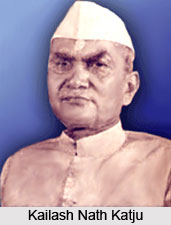Kailash Nath Katju was considered as one of the foremost Indian freedom fighters who fought against the British Empire in India and significantly contributed to the Indian freedom struggle. He was also a renowned Indian politician and was among the leading lawyers in the country. He was a significant part of the Indian National Army Trials at Red Fort. Dr. Katju became a part of the Indian freedom struggle against the rule of the British Empire in India and spent many years imprisoned along with other well known freedom fighters and independence activists. Later Kailash Nath Katju served as the Governor of Orissa, the Governor of West Bengal, the Chief Minister of Madhya Pradesh state, the Union Home Minister, the Union Law Minister and the Union Defence Minister.
Early Life of Kailash Nath Katju
Kailash Nath Katju was born on 17th June 1887 in Jaora in the present Indian state of Madhya Pradesh. Pandit Tribhuvan Nath, his father, belonged to a Kashmiri Brahmin family who settled in the princely state of Jaora. Katju was educated in the Jaora School until March, 1900, after which he went to Lahore. He completed his matriculation examination from the University of Punjab in the year 1901 and successfully passed his B.A. examination from the Christian College in Lahore in the year 1905. He was appointed at the Muir Central College at Allahabad in July, 1905.
Kailash Nath Katju successfully completed his L.L.B. Examination from the Allahabad University in September, 1907 and became second in the state. Later in the year 1908, Katju passed his Master of Arts in History from the Allahabad University. In the same year, he began his career was a lawyer at Kanpur. He moved to Allahabad in the year 1914 and achieved his L.L.D. degree in 1919.
 Political Career of Kailash Nath Katju
Political Career of Kailash Nath Katju
In the year 1933, Kailash Nath Katju defended the accused in the Meerut Conspiracy Case in Allahabad High Court. He, along with Jawaharlal Nehru, Bhulabhai Desai, Sir Tej Bahadur Sapru, Asaf Ali and others also defended the freedom fighters and officers of the Indian National Army in the INA trials at Red Fort in Delhi. Raja Habib Ur Rahman Khan, Colonel Prem Kumar Sahgal and General Shah Nawaz Khan and Colonel Gurbaksh Singh Dhillon were put on trial for waging war against the British Emperor on November 5, 1945. Katju defended them and demanded that the soldiers of the Provisional Government of Free India should be treated as prisoners of war.
Kailash Nath Katju was appointed as the Minister of Law and Justice and Parliamentary Affairs of the United Provinces in the cabinet of Govind Ballabh Pant on 17th July 1937. On 2nd November 1939, the ministry resigned and he was imprisoned for almost 18 months. Katju was imprisoned again in the year 1942. Later he served in the Constituent Assembly of India.
After the nation achieved independence from the British Government of India, he held a number of high political designations. He was appointed as the Governor of Orissa and served office from 15th August 1947 to 20th June 1948. Kailash Nath Katju also became the Governor of West Bengal on 21st June 1948 and served in office till 31st October 1951. He was elected to the Lok Sabha from the Mandsaur constituency in the year 1951 and joined the cabinet of Jawaharlal Nehru as Law Minister. He became the 3rd Home Minister of the country by succeeding C. Rajagopalachari in November 1951. Katju was appointed as the Defence Minister in 1955 and later on 31st January 1957 he became the Chief Minister of Madhya Pradesh and served in office till 11th March 1962. In the year 1963, Kailash Nath Katju retired from politics. He died on 17th February 1968.
Publications of Kailash Nath Katju
Dr. Kailash Nath Katju wrote and published a number of books namely, "The days I remember", "Reminiscences and experiments in advocacy" and "Experiments in Advocacy: A Colossus in the Courts of Justice". He also wrote several articles and delivered memorable speeches as well.



















